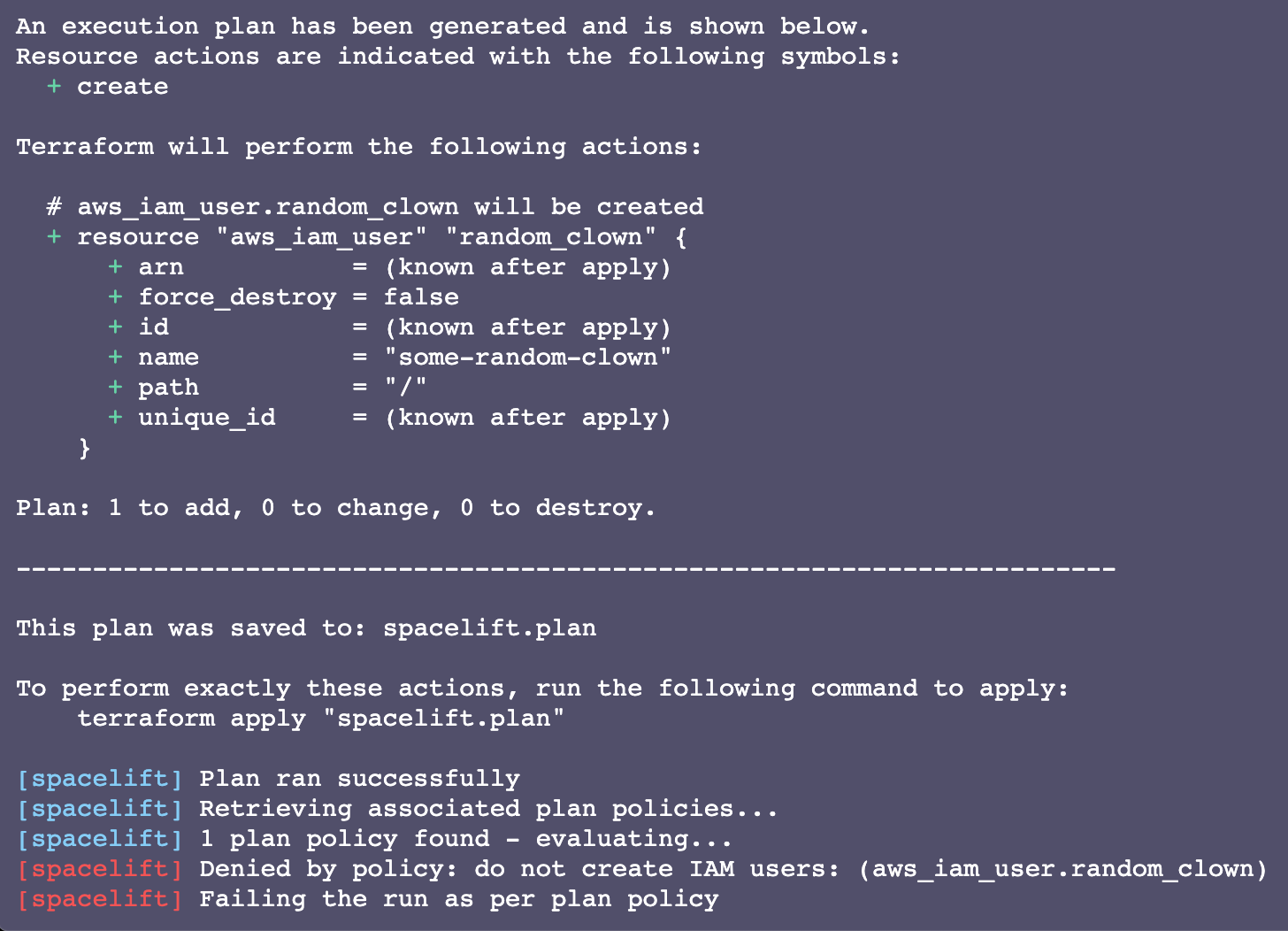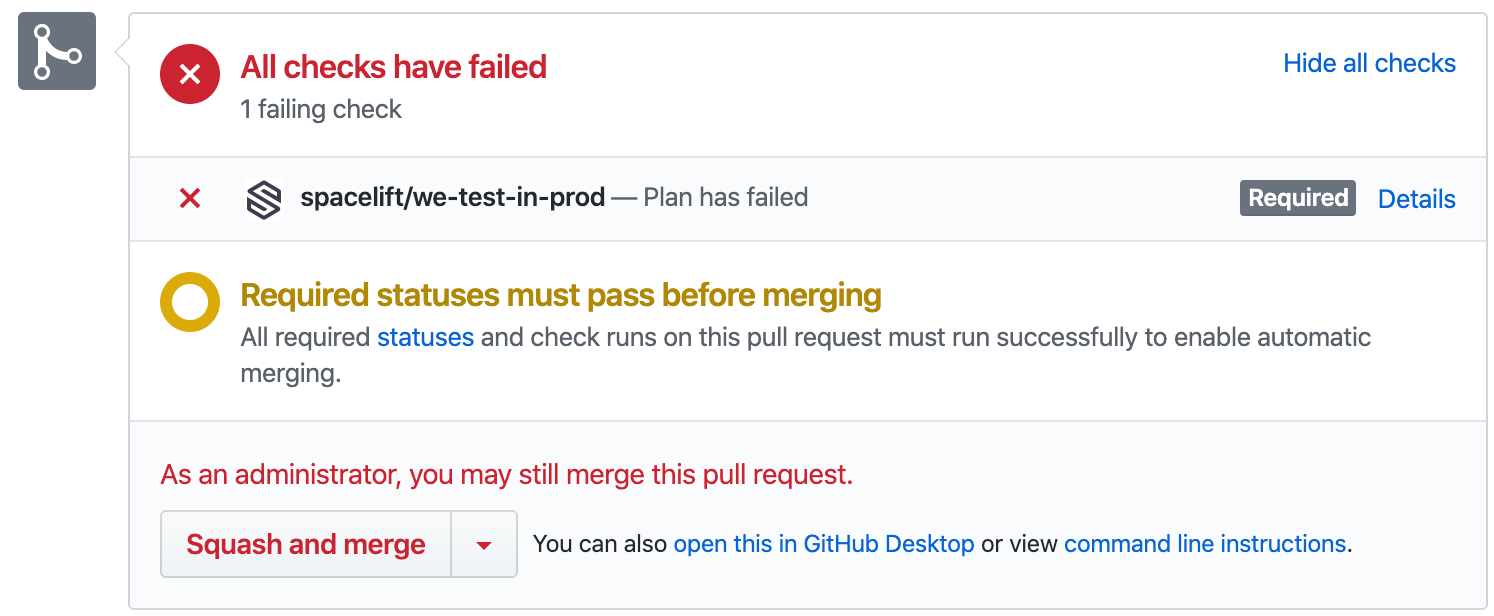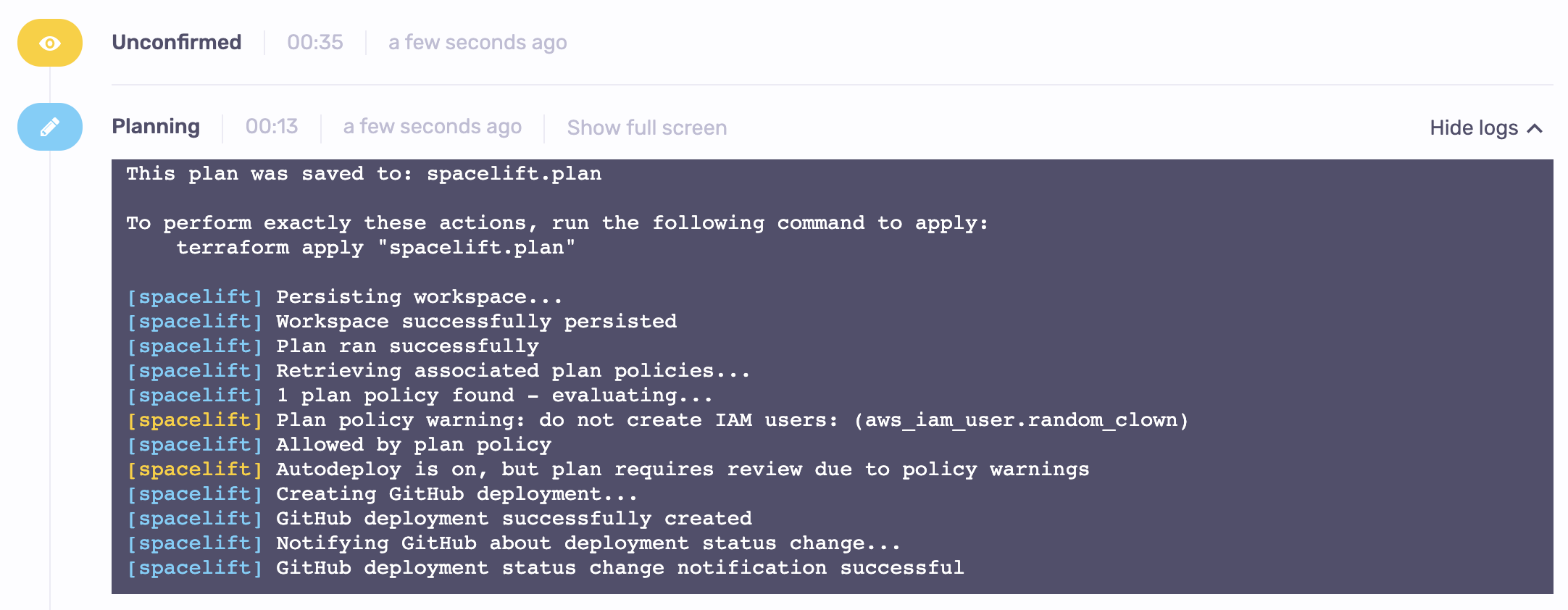Plan policy»
Purpose»
Plan policies are evaluated during a planning phase after a vendor-specific change preview command (e.g. terraform plan) executes successfully. The body of the change is exported to JSON and parts of it are combined with Spacelift metadata to form the data input to the policy.
Plan policies are the only ones with access to the actual changes to the managed resources, making them the best place to enforce organizational rules and best practices as well as do automated code review.
There are two types of rules here that Spacelift will care about: deny and warn. Each of them must come with an appropriate message that will be shown in the logs.
- Deny rules: Print in red. Automatically fail the run.
- Warn rules: Print in yellow. At most, mark the run for human review if the change affects the tracked branch and the stack is set to autodeploy.
This simple policy will show both types of rules in action:
1 2 3 4 5 6 7 8 9 | |
If you create this policy, attach it to a stack, and trigger a run, you will see something like this:

It works, but it's not terribly useful unless you want to block all changes to your stack in a really clumsy way.
Let's dig deeper into the data input document that each plan policy receives, two possible use cases (rule enforcement and automated code review) and some examples.
Data input»
This is the data input schema each policy request will receive. If the policy is executed for the first time, the previous_run field will be missing.
Official Schema Reference
For the most up-to-date and complete schema definition, please refer to the official Spacelift policy contract schema under the PLAN policy type.
1 2 3 4 5 6 7 8 9 10 11 12 13 14 15 16 17 18 19 20 21 22 23 24 25 26 27 28 29 30 31 32 33 34 35 36 37 38 39 40 41 42 43 44 45 46 47 48 49 50 51 52 53 54 55 56 57 58 59 60 61 62 63 64 65 66 67 68 69 70 71 72 73 74 75 76 77 78 79 80 81 82 83 84 85 86 87 88 89 90 91 92 93 94 95 96 97 98 99 100 101 102 103 104 105 106 107 108 109 110 111 112 113 114 115 116 117 118 119 120 121 122 123 124 125 126 127 128 129 130 131 132 133 134 135 136 137 138 139 140 141 142 143 144 | |
Aliases»
In addition to our helper functions, we provide aliases for commonly used parts of the input data:
| Alias | Description |
|---|---|
affected_resources |
List of the resources that will be created, deleted, and updated by Terraform |
created_resources |
List of the resources that will be created by Terraform |
deleted_resources |
List of the resources that will be deleted by Terraform |
recreated_resources |
List of the resources that will be deleted and then created by Terraform |
updated_resources |
List of the resources that will be updated by Terraform |
String sanitization»
Sensitive properties in "before" and "after" objects will be sanitized to protect secret values. Sanitization hashes the value with the sha256 algorithm and takes the last 8 bytes of the hash.
If you need to compare a string property to a constant, use the sanitized(string) helper function.
1 2 3 4 5 6 7 8 9 10 | |
Custom inputs»
Sometimes you need to pass some additional data to your policy input. For example, you may want to pass the result of a third-party API to tool call to the configuration data from the Terraform plan. To use custom inputs:
- Generate a JSON file with the data you need at the root of your project.
- The file name must follow the pattern
$key.custom.spacelift.jsonand represent a valid JSON object.- The file name is case-sensitive.
- The object will be merged with the rest of the input data, as
input.third_party_metadata.custom.$key.
Below are two examples, one exposing Terraform configuration and the other exposing the result of a third-party security tool.
Tip
To learn more about integrating security tools with Spacelift using custom inputs, refer to our blog post.
Exposing Terraform configuration to the plan policy»
To expose the Terraform configuration to the plan policy to ensure that only the "blessed" modules are used to provision resources, add this command to the list of after_plan hooks:
1 | |
The data will be available in the policy input as input.third_party_metadata.custom.configuration. This depends on the jq tool being available in the runner image. It is installed by default on our standard image.
Passing custom tool output to the plan policy»
For this example, we will generate warnings (from the open-source Terraform security scanner tfsec) as JSON and have them reported and processed using the plan policy.
Run tfsec as a before_init hook and save the output to a file:
1 | |
The data will be available in the policy input as input.third_party_metadata.custom.tfsec. This depends on the tfsec tool being available in the runner image, which you will need to install either directly on the image or as part of your before_init hook.
Some vulnerability scanning tools, like tfsec, will return a non-zero exit code when they encounter vulnerabilities, which will result in a stack failure. The majority of these tools provide a soft scanning option that will show all the vulnerabilities without considering the command as failed, which we will use instead.
If your tool doesn't offer soft scanning, append || true at the end of the command, which always returns a zero exit code.
Use cases»
Since plan policies have access to the infrastructure changes that are about to be introduced, you can run all sorts of checks against those changes. There are two main use cases for those checks:
- Organizational rule enforcement to prevent rules that go against organizational policies.
- Automated code review to augment human decision-making.
Organizational rule enforcement»
In every organization, there are some things you do not touch, such as:
- A particular line of code surrounded by comments warning, if you change it, the site will go down and the on-call personnel will be after you.
- Potential security vulnerabilities that can expose all your infrastructure to the wrong crowd.
Spacelift can turn these organizational hard rules into policies that can't be broken. You will most likely want to exclusively use deny rules.
In this example, we introduce a simple rule: never create static AWS credentials.
1 2 3 4 5 6 7 8 9 10 11 12 13 14 15 16 | |
This slightly more sophisticated policy states that when some resources are recreated, they should be created before they're destroyed or an outage will follow. We found this to be an issue with aws_batch_compute_environment, among other resources.
1 2 3 4 5 6 7 8 9 10 11 12 13 14 15 16 17 18 19 | |
While in most cases you'll want your rules to only look at resources affected by the change, you're not limited to doing so. You can look at all resources and force teams to remove certain resources. Here's an example where until AWS resources are all removed in one go, no further changes can take place:
1 2 3 4 5 6 7 8 9 10 11 | |
Automated code review»
In addition to enforcing hard rules, plan policy rules can help humans understand changes better and make informed decisions on what looks good and what does not.
Warn rules look like this:

The warn rule won't fail your plan and can provide great help to a human reviewer, especially when multiple changes are introduced. Also, if a stack is set to autodeploy, the presence of a single warning is enough to flag the run for a human review.
The best way to use warn and deny rules together depends on your preferred Git workflow. We've found short-lived feature branches with Pull Requests to the tracked branch to work relatively well. In this scenario, the type of the run is important: PROPOSED for commits to feature branches, and TRACKED on commits to the tracked branch. Your rules should use this mechanism to balance comprehensive feedback on Pull Requests and the flexibility of being able to deploy things that humans deem appropriate.
As a general rule when using plan policies for code review, deny when run type is PROPOSED and warn when it is TRACKED. Denying tracked runs unconditionally may be a good idea for most egregious violations, but when this approach is taken to an extreme it can make your life difficult.
We suggest that you at most deny when the run is PROPOSED, which will send a failure status to the GitHub commit, then give the reviewer a chance to approve the change anyways. If you want a human to take another look before those changes go live, either set stack autodeploy to false or explicitly warn about potential violations. Here's an example of how to reuse the same rule to deny or warn depending on the run type:
1 2 3 4 5 6 7 8 9 10 11 12 13 | |
Predictably, this fails when committed to a non-tracked (feature) branch:

...but as a GitHub repo admin you can still merge it if you've set your branch protection rules accordingly:

If we squash and merge:

The run stopped to await a human decision. At this point, we still have a choice to either confirm or discard the run. In the latter case, you will likely want to revert the commit that caused the problem, otherwise all subsequent runs will be affected.
Examples»
Tip
We maintain a library of example policies that are ready to use or alter to meet your specific needs.
If you cannot find what you are looking for below or in the library, please reach out to our support and we will craft a policy to do exactly what you need.
Require human review when resources are changed»
Adding resources may cost a lot of money, but it's usually safe from an operational perspective. Let's use a warn rule to allow changes with only added resources to get automatically applied, and require all others to get a human review:
1 2 3 4 5 6 7 8 9 10 11 | |
Automatically deploy changes from selected individuals»
Sometimes changes introduced by trusted individuals can be deployed automatically, especially if they already went through code review. This example allows commits from allowlisted individuals to be deployed automatically (and assumes the stack is set to autodeploy):
1 2 3 4 5 6 7 8 9 | |
Require commits to be reasonably sized»
Massive changes make reviewers miserable. In this example, we automatically fail all changes that affect more than 50 resources but allow them to be deployed with mandatory human review:
1 2 3 4 5 6 7 8 9 10 11 12 13 14 15 16 | |
Back-of-the-envelope blast radius»
This is a fancy contrived example building on top of the previous one. However, rather than looking at the total number of affected resources, it attempts to create a metric called a "blast radius": how much the change will affect the whole stack.
It assigns special multipliers to some types of resources changed and treats different types of changes differently: deletes and updates are more "expensive" because they affect live resources, while new resources are generally safer and thus "cheaper". Per our automated code review pattern, we will fail Pull Requests with changes violating this policy, but require human action through warnings when these changes hit the tracked branch.
1 2 3 4 5 6 7 8 9 10 11 12 13 14 15 16 17 18 19 20 21 22 23 24 25 26 27 28 29 30 31 32 33 34 35 | |
Cost management»
Thanks to our Infracost integration, you can take cost information into account when deciding whether to ask for human approval or to block changes entirely.